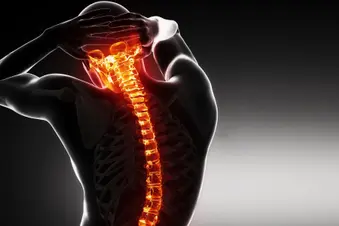
By Jed Finley, as told to Janie McQueen
I was diagnosed with ankylosing spondylitis (AS) in 1994 when I was 12 years old. It’s becoming more common to diagnose younger people as doctors get familiar with AS. But there weren’t a whole lot of options available back then, so I left it untreated for a long time.
I played ice hockey and other sports when I was a kid, so I was used to being in pain from working out. In my early 20s, though, I realized there was something really wrong. My knees, hips, and ankles creaked and cracked with every step. I started hunching over, and people really started noticing. As a senior in college, my roommates called me “the old man.” It was obvious I was a lot more creaky than a twenty-something should be.
I wasn’t able to do as much as I used to because of the joint and back pain. I was a distance runner, and one day in the middle of a 10-mile run, I pulled a full-force Forrest Gump. I stopped and said, “You know what, I’m done.” I just walked home, and that was the end of it.
I checked in with a rheumatologist who knew what I had. I was lucky. It can be really hard to get the diagnosis for so many people. Unless you have the fusion of your spine on an X-ray, there’s not a whole lot of physical evidence. Even in my case, I’m not 100% fused anywhere, though I’m really close in a few places.
Mental Challenges
At first it was like, “Mind over matter.” You’re doing OK, but then … you’re not. Mentally, it’s hard living this way. To think I used to be so active -- it can kind of bring you down. I’m not that old, having just turned 39. My pain is getting worse. Sometimes I feel like it’s all downhill from here. For example, I’m a special education teacher. I used to work in an autism center, which was very active. I always had to have the rule, “No lifting.” No getting down on the floor, because I couldn’t get up. I had to change my job plan and do more of a resource worker thing. Those kinds of changes were tough. So the mental side is the most draining part of AS -- just realizing my limitations.
Finding the Bright Side
In 2007, I started a support group on Facebook for people who live with AS. I just wanted to make contact with other people. I’d never met anyone else with it. Today, it has 29,500 members. I also run a support group in St. Louis for the Spondylitis Association of America and advocate through lots of other organizations, like CreakyJoints. I’ve found a lot of health and therapy through leading support groups. I like to say that my AS gave me pride and purpose. It gave me that area of expertise that allows me to do so much in the community.
Exploring Alternate Treatments
I did physical therapy for about a year, and it was OK. I did core strengthening and things that take the pressure off your spine, make you more flexible, and so on, and that was good. I see a chiropractor semi-regularly, which is a real divisive issue in the AS community. But I decided to go in for a free consultation that came with X-rays. The chiropractor showed me that I had issues with my spine, not just AS. I started getting these bits figured out. For example, my hip had always been tilted. I never could lean or turn a certain way. So I got my hips in balance with chiropractic therapy, and it’s been a huge help. I’m even trying to get back into walking again.
Keeping Flare-Ups at Bay
AS is a lifelong condition, but it has flare-ups as well. The weather, with air pressure changes. Dairy, sugar. They’re all triggers. I avoid dairy 100%. I try to avoid heavy stress. I take an amino acid drink mix that helps with circulation. It cuts inflammation and clears my head of the brain fog that comes with AS. To help me relax, I like to draw, and I really enjoy writing. I write for a couple of blog sites, and that’s therapeutic. I always like to say that although lots of people haven’t heard of AS, it’s not really rare. In fact, a 2012 CDC study found 2.7 million Americans have axial spondyloarthritis, which is the umbrella classification AS falls under. The more the word gets out and doctors learn what to look for, the more people who can get diagnosed and get in treatment.
Show Sources
SOURCE:
Jed Finley, St. Louis, MO.